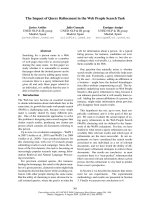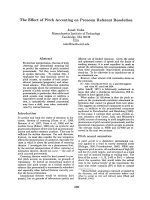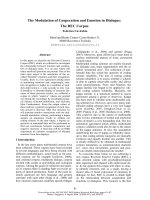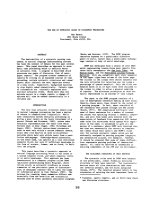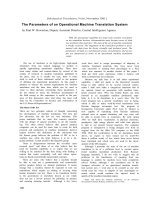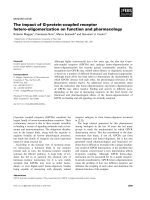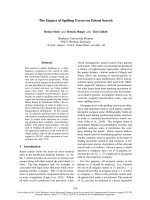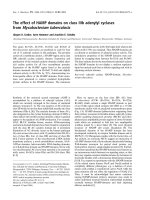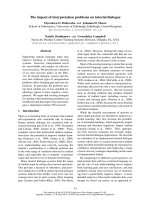Báo cáo khoa học: "The impact of interpretation problems on tutorial dialogue" doc
Bạn đang xem bản rút gọn của tài liệu. Xem và tải ngay bản đầy đủ của tài liệu tại đây (116.74 KB, 6 trang )
Proceedings of the ACL 2010 Conference Short Papers, pages 43–48,
Uppsala, Sweden, 11-16 July 2010.
c
2010 Association for Computational Linguistics
The impact of interpretation problems on tutorial dialogue
Myroslava O. Dzikovska and Johanna D. Moore
School of Informatics, University of Edinburgh, Edinburgh, United Kingdom
{m.dzikovska,j.moore}@ed.ac.uk
Natalie Steinhauser and Gwendolyn Campbell
Naval Air Warfare Center Training Systems Division, Orlando, FL, USA
{natalie.steihauser,gwendolyn.campbell}@navy.mil
Abstract
Supporting natural language input may
improve learning in intelligent tutoring
systems. However, interpretation errors
are unavoidable and require an effective
recovery policy. We describe an evaluation
of an error recovery policy in the BEE-
TLE II tutorial dialogue system and dis-
cuss how different types of interpretation
problems affect learning gain and user sat-
isfaction. In particular, the problems aris-
ing from student use of non-standard ter-
minology appear to have negative conse-
quences. We argue that existing strategies
for dealing with terminology problems are
insufficient and that improving such strate-
gies is important in future ITS research.
1 Introduction
There is a mounting body of evidence that student
self-explanation and contentful talk in human-
human tutorial dialogue are correlated with in-
creased learning gain (Chi et al., 1994; Purandare
and Litman, 2008; Litman et al., 2009). Thus,
computer tutors that understand student explana-
tions have the potential to improve student learn-
ing (Graesser et al., 1999; Jordan et al., 2006;
Aleven et al., 2001; Dzikovska et al., 2008). How-
ever, understanding and correctly assessing the
student’s contributions is a difficult problem due
to the wide range of variation observed in student
input, and especially due to students’ sometimes
vague and incorrect use of domain terminology.
Many tutorial dialogue systems limit the range
of student input by asking short-answer questions.
This provides a measure of robustness, and previ-
ous evaluations of ASR in spoken tutorial dialogue
systems indicate that neither word error rate nor
concept error rate in such systems affect learning
gain (Litman and Forbes-Riley, 2005; Pon-Barry
et al., 2004). However, limiting the range of pos-
sible input limits the contentful talk that the stu-
dents are expected to produce, and therefore may
limit the overall effectiveness of the system.
Most of the existing tutoring systems that accept
unrestricted language input use classifiers based
on statistical text similarity measures to match
student answers to open-ended questions with
pre-authored anticipated answers (Graesser et al.,
1999; Jordan et al., 2004; McCarthy et al., 2008).
While such systems are robust to unexpected ter-
minology, they provide only a very coarse-grained
assessment of student answers. Recent research
aims to develop methods that produce detailed
analyses of student input, including correct, in-
correct and missing parts (Nielsen et al., 2008;
Dzikovska et al., 2008), because the more detailed
assessments can help tailor tutoring to the needs of
individual students.
While the detailed assessments of answers to
open-ended questions are intended to improve po-
tential learning, they also increase the probabil-
ity of misunderstandings, which negatively impact
tutoring and therefore negatively impact student
learning (Jordan et al., 2009). Thus, appropri-
ate error recovery strategies are crucially impor-
tant for tutorial dialogue applications. We describe
an evaluation of an implemented tutorial dialogue
system which aims to accept unrestricted student
input and limit misunderstandings by rejecting low
confidence interpretations and employing a range
of error recovery strategies depending on the cause
of interpretation failure.
By comparing two different system policies, we
demonstrate that with less restricted language in-
put the rate of non-understanding errors impacts
both learning gain and user satisfaction, and that
problems arising from incorrect use of terminol-
ogy have a particularly negative impact. A more
detailed analysis of the results indicates that, even
though we based our policy on an approach ef-
43
fective in task-oriented dialogue (Hockey et al.,
2003), many of our strategies were not success-
ful in improving learning gain. At the same time,
students appear to be aware that the system does
not fully understand them even if it accepts their
input without indicating that it is having interpre-
tation problems, and this is reflected in decreased
user satisfaction. We argue that this indicates that
we need better strategies for dealing with termi-
nology problems, and that accepting non-standard
terminology without explicitly addressing the dif-
ference in acceptable phrasing may not be suffi-
cient for effective tutoring.
In Section 2 we describe our tutoring system,
and the two tutoring policies implemented for the
experiment. In Section 3 we present experimen-
tal results and an analysis of correlations between
different types of interpretation problems, learning
gain and user satisfaction. Finally, in Section 4 we
discuss the implications of our results for error re-
covery policies in tutorial dialogue systems.
2 Tutorial Dialogue System and Error
Recovery Policies
This work is based on evaluation of BEETLE II
(Dzikovska et al., 2010), a tutorial dialogue sys-
tem which provides tutoring in basic electricity
and electronics. Students read pre-authored mate-
rials, experiment with a circuit simulator, and then
are asked to explain their observations. BEETLE II
uses a deep parser together with a domain-specific
diagnoser to process student input, and a deep gen-
erator to produce tutorial feedback automatically
depending on the current tutorial policy. It also
implements an error recovery policy to deal with
interpretation problems.
Students currently communicate with the sys-
tem via a typed chat interface. While typing
removes the uncertainty and errors involved in
speech recognition, expected student answers are
considerably more complex and varied than in
a typical spoken dialogue system. Therefore, a
significant number of interpretation errors arise,
primarily during the semantic interpretation pro-
cess. These errors can lead to non-understandings,
when the system cannot produce a syntactic parse
(or a reasonable fragmentary parse), or when it
does not know how to interpret an out-of-domain
word; and misunderstandings, where a system ar-
rives at an incorrect interpretation, due to either
an incorrect attachment in the parse, an incorrect
word sense assigned to an ambiguous word, or an
incorrectly resolved referential expression.
Our approach to selecting an error recovery pol-
icy is to prefer non-understandings to misunder-
standings. There is a known trade-off in spoken di-
alogue systems between allowing misunderstand-
ings, i.e., cases in which a system accepts and
acts on an incorrect interpretation of an utterance,
and non-understandings, i.e., cases in which a sys-
tem rejects an utterance as uninterpretable (Bo-
hus and Rudnicky, 2005). Since misunderstand-
ings on the part of a computer tutor are known
to negatively impact student learning, and since
in human-human tutorial dialogue the majority of
student responses using unexpected terminology
are classified as incorrect (Jordan et al., 2009),
it would be a reasonable approach for a tutorial
dialogue system to deal with potential interpreta-
tion problems by treating low-confidence interpre-
tations as non-understandings and focusing on an
effective non-understanding recovery policy.
1
We implemented two different policies for com-
parison. Our baseline policy does not attempt any
remediation or error recovery. All student utter-
ances are passed through the standard interpreta-
tion pipeline, so that the results can be analyzed
later. However, the system does not attempt to ad-
dress the student content. Instead, regardless of
the answer analysis, the system always uses a neu-
tral acceptance and bottom out strategy, giving the
student the correct answer every time, e.g., “OK.
One way to phrase the correct answer is: the open
switch creates a gap in the circuit”. Thus, the stu-
dents are never given any indication of whether
they have been understood or not.
The full policy acts differently depending on the
analysis of the student answer. For correct an-
swers, it acknowledges the answer as correct and
optionally restates it (see (Dzikovska et al., 2008)
for details). For incorrect answers, it restates the
correct portion of the answer (if any) and provides
a hint to guide the student towards the completely
correct answer. If the student’s utterance cannot be
interpreted, the system responds with a help mes-
sage indicating the cause of the problem together
with a hint. In both cases, after 3 unsuccessful at-
tempts to address the problem the system uses the
bottom out strategy and gives away the answer.
1
While there is no confidence score from a speech recog-
nizer, our system uses a combination of a parse quality score
assigned by the parser and a set of consistency checks to de-
termine whether an interpretation is sufficiently reliable.
44
The content of the bottom out is the same as in
the baseline, except that the full system indicates
clearly that the answer was incorrect or was not
understood, e.g., “Not quite. Here is the answer:
the open switch creates a gap in the circuit”.
The help messages are based on the Targeted-
Help approach successfully used in spoken dia-
logue (Hockey et al., 2003), together with the error
classification we developed for tutorial dialogue
(Dzikovska et al., 2009). There are 9 different er-
ror types, each associated with a different targeted
help message. The goal of the help messages is to
give the student as much information as possible
as to why the system failed to understand them but
without giving away the answer.
In comparing the two policies, we would expect
that the students in both conditions would learn
something, but that the learning gain and user sat-
isfaction would be affected by the difference in
policies. We hypothesized that students who re-
ceive feedback on their errors in the full condition
would learn more compared to those in the base-
line condition.
3 Evaluation
We collected data from 76 subjects interacting
with the system. The subjects were randomly as-
signed to either the baseline (BASE) or the full
(FULL) policy condition. Each subject took a pre-
test, then worked through a lesson with the system,
and then took a post-test and filled in a user satis-
faction survey. Each session lasted approximately
4 hours, with 232 student language turns in FULL
(SD = 25.6) and 156 in BASE (SD = 2.02). Ad-
ditional time was taken by reading and interact-
ing with the simulation environment. The students
had little prior knowledge of the domain. The sur-
vey consisted of 63 questions on the 5-point Lik-
ert scale covering the lesson content, the graphical
user interface, and tutor’s understanding and feed-
back. For purposes of this study, we are using an
averaged tutor score.
The average learning gain was 0.57 (SD =
0.23) in FULL, and 0.63 (SD = 0.26) in BASE.
There was no significant difference in learning
gain between conditions. Students liked BASE bet-
ter: the average tutor evaluation score for FULL
was 2.56 out of 5 (SD = 0.65), compared to 3.32
(SD = 0.65) in BASE. These results are signif-
icantly different (t-test, p < 0.05). In informal
comments after the session many students said that
they were frustrated when the system said that it
did not understand them. However, some students
in BASE also mentioned that they sometimes were
not sure if the system’s answer was correcting a
problem with their answer, or simply phrasing it
in a different way.
We used mean frequency of non-interpretable
utterances (out of all student utterances in
each session) to evaluate the effectiveness of
the two different policies. On average, 14%
of utterances in both conditions resulted in
non-understandings.
2
The frequency of non-
understandings was negatively correlated with
learning gain in FULL: r = −0.47, p < 0.005,
but not significantly correlated with learning gain
in BASE: r = −0.09, p = 0.59. However, in both
conditions the frequency of non-understandings
was negatively correlated with user satisfaction:
FULL r = −0.36, p = 0.03, BASE r = −0.4, p =
0.01. Thus, even though in BASE the system
did not indicate non-understanding, students were
negatively affected. That is, they were not satis-
fied with the policy that did not directly address
the interpretation problems. We discuss possible
reasons for this below.
We investigated the effect of different types of
interpretation errors using two criteria. First, we
checked whether the mean frequency of errors was
reduced between BASE and FULL for each individ-
ual strategy. The reduced frequency means that
the recovery strategy for this particular error type
is effective in reducing the error frequency. Sec-
ond, we looked for the cases where the frequency
of a given error type is negatively correlated with
either learning gain or user satisfaction. This is
provides evidence that such errors are negatively
impacting the learning process, and therefore im-
proving recovery strategies for those error types is
likely to improve overall system effectiveness,
The results, shown in Table 1, indicate that the
majority of interpretation problems are not sig-
nificantly correlated with learning gain. How-
ever, several types of problems appear to be
particularly significant, and are all related to
improper use of domain terminology. These
were irrelevant answer, no appr terms, selec-
tional restriction failure and program error.
An irrelevant answer error occurs when the stu-
dent makes a statement that uses domain termi-
2
We do not know the percentage of misunderstandings or
concept error rate as yet. We are currently annotating the data
with the goal to evaluate interpretation correctness.
45
full baseline
error type
mean freq.
(std. dev)
satisfac-
tion r
gain
r
mean freq
(std. dev)
satisfac-
tion r
gain
r
irrelevant answer 0.008 (0.01) -0.08 -0.19 0.012 (0.01) -0.07 -0.47**
no appr terms 0.005 (0.01) -0.57** -0.42** 0.003 (0.01) -0.38** -0.01
selectional restr failure 0.032 (0.02) -0.12 -0.55** 0.040 (0.03) 0.13 0.26*
program error 0.002 (0.003) 0.02 0.26 0.003 (0.003) 0 -0.35**
unknown word 0.023 (0.01) 0.05 -0.21 0.024 (0.02) -0.15 -0.09
disambiguation failure 0.013 (0.01) -0.04 0.02 0.007 (0.01) -0.18 0.19
no parse 0.019 (0.01) -0.14 -0.08 0.022(0.02) -0.3* 0.01
partial interpretation 0.004 (0.004) -0.11 -0.01 0.004 (0.005) -0.19 0.22
reference failure 0.012 (0.02) -0.31* -0.09 0.017 (0.01) -0.15 -0.23
Overall 0.134 (0.05) -0.36** -0.47** 0.139 (0.04) -0.4** -0.09
Table 1: Correlations between frequency of different error types and student learning gain and satisfac-
tion. ** - correlation is significant with p < 0.05, * - with p <= 0.1.
nology but does not appear to answer the system’s
question directly. For example, the expected an-
swer to “In circuit 1, which components are in a
closed path?” is “the bulb”. Some students mis-
read the question and say “Circuit 1 is closed.” If
that happens, in FULL the system says “Sorry, this
isn’t the form of answer that I expected. I am look-
ing for a component”, pointing out to the student
the kind of information it is looking for. The BASE
system for this error, and for all other errors dis-
cussed below, gives away the correct answer with-
out indicating that there was a problem with in-
terpreting the student’s utterance, e.g., “OK, the
correct answer is the bulb.”
The no appr terms error happens when the stu-
dent is using terminology inappropriate for the les-
son in general. Students are expected to learn to
explain everything in terms of connections and ter-
minal states. For example, the expected answer to
“What is voltage?” is “the difference in states be-
tween two terminals”. If instead the student says
“Voltage is electricity”, FULL responds with “I am
sorry, I am having trouble understanding. I see no
domain concepts in your answer. Here’s a hint:
your answer should mention a terminal.” The mo-
tivation behind this strategy is that in general, it is
very difficult to reason about vaguely used domain
terminology. We had hoped that by telling the stu-
dent that the content of their utterance is outside
the domain as understood by the system, and hint-
ing at the correct terms to use, the system would
guide students towards a better answer.
Selectional restr failure errors are typically due
to incorrect terminology, when the students
phrased answers in a way that contradicted the sys-
tem’s domain knowledge. For example, the sys-
tem can reason about damaged bulbs and batter-
ies, and open and closed paths. So if the stu-
dent says “The path is damaged”, the FULL sys-
tem would respond with “I am sorry, I am having
trouble understanding. Paths cannot be damaged.
Only bulbs and batteries can be damaged.”
Program error were caused by faults in the un-
derlying network software, but usually occurred
when the student was using extremely long and
complicated utterances.
Out of the four important error types described
above, only the strategy for irrelevant answer was
effective: the frequency of irrelevant answer er-
rors is significantly higher in BASE (t-test, p <
0.05), and it is negatively correlated with learning
gain in BASE. The frequencies of other error types
did not significantly differ between conditions.
However, one other finding is particularly in-
teresting: the frequency of no appr terms errors
is negatively correlated with user satisfaction in
BASE. This indicates that simply accepting the stu-
dent’s answer when they are using incorrect termi-
nology and exposing them to the correct answer is
not the best strategy, possibly because the students
are noticing the unexplained lack of alignment be-
tween their utterance and the system’s answer.
4 Discussion and Future Work
As discussed in Section 1, previous studies of
short-answer tutorial dialogue systems produced a
counter-intuitive result: measures of interpretation
accuracy were not correlated with learning gain.
With less restricted language, misunderstandings
46
negatively affected learning. Our study provides
further evidence that interpretation quality signif-
icantly affects learning gain in tutorial dialogue.
Moreover, while it has long been known that user
satisfaction is negatively correlated with interpre-
tation error rates in spoken dialogue, this is the
first attempt to evaluate the impact of different
types of interpretation errors on task success and
usability of a tutoring system.
Our results demonstrate that different types of
errors may matter to a different degree. In our
system, all of the error types negatively correlated
with learning gain stem from the same underlying
problem: the use of incorrect or vague terminol-
ogy by the student. With the exception of the ir-
relevant answer strategy, the targeted help strate-
gies we implemented were not effective in reduc-
ing error frequency or improving learning gain.
Additional research is needed to understand why.
One possibility is that irrelevant answer was eas-
ier to remediate compared to other error types. It
usually happened in situations where there was a
clear expectation of the answer type (e.g., a list of
component names, a yes/no answer). Therefore,
it was easier to design an effective prompt. Help
messages for other error types were more frequent
when the expected answer was a complex sen-
tence, and multiple possible ways of phrasing the
correct answer were acceptable. Therefore, it was
more difficult to formulate a prompt that would
clearly describe the problem in all contexts.
One way to improve the help messages may be
to have the system indicate more clearly when user
terminology is a problem. Our system apologized
each time there was a non-understanding, leading
students to believe that they may be answering cor-
rectly but the answer is not being understood. A
different approach would be to say something like
“I am sorry, you are not using the correct termi-
nology in your answer. Here’s a hint: your answer
should mention a terminal”. Together with an ap-
propriate mechanism to detect paraphrases of cor-
rect answers (as opposed to vague answers whose
correctness is difficult to determine), this approach
could be more beneficial in helping students learn.
We are considering implementing and evaluating
this as part of our future work.
Some of the errors, in particular instances of
no appr terms and selectional restr failure, also
stemmed from unrecognized paraphrases with
non-standard terminology. Those answers could
conceivably be accepted by a system using seman-
tic similarity as a metric (e.g., using LSA with pre-
authored answers). However, our results also indi-
cate that simply accepting the incorrect terminol-
ogy may not be the best strategy. Users appear to
be sensitive when the system’s language does not
align with their terminology, as reflected in the de-
creased satisfaction ratings associated with higher
rates of incorrect terminology problems in BASE.
Moreover, prior analysis of human-human data
indicates that tutors use different restate strate-
gies depending on the “quality” of the student an-
swers, even if they are accepting them as correct
(Dzikovska et al., 2008). Together, these point at
an important unaddressed issue: existing systems
are often built on the assumption that only incor-
rect and missing parts of the student answer should
be remediated, and a wide range of terminology
should be accepted (Graesser et al., 1999; Jordan
et al., 2006). While it is obviously important for
the system to accept a range of different phrasings,
our analysis indicates that this may not be suffi-
cient by itself, and students could potentially ben-
efit from addressing the terminology issues with a
specifically devised strategy.
Finally, it could also be possible that some
differences between strategy effectiveness were
caused by incorrect error type classification. Man-
ual examination of several dialogues suggests that
most of the errors are assigned to the appropri-
ate type, though in some cases incorrect syntac-
tic parses resulted in unexpected interpretation er-
rors, causing the system to give a confusing help
message. These misclassifications appear to be
evenly split between different error types, though
a more formal evaluation is planned in the fu-
ture. However from our initial examination, we
believe that the differences in strategy effective-
ness that we observed are due to the actual differ-
ences in the help messages. Therefore, designing
better prompts would be the key factor in improv-
ing learning and user satisfaction.
Acknowledgments
This work has been supported in part by US Office
of Naval Research grants N000140810043 and
N0001410WX20278. We thank Katherine Harri-
son, Leanne Taylor, Charles Callaway, and Elaine
Farrow for help with setting up the system and
running the evaluation. We would like to thank
anonymous reviewers for their detailed feedback.
47
References
V. Aleven, O. Popescu, and K. R. Koedinger. 2001.
Towards tutorial dialog to support self-explanation:
Adding natural language understanding to a cogni-
tive tutor. In Proceedings of the 10
th
International
Conference on Artificial Intelligence in Education
(AIED ’01)”.
Dan Bohus and Alexander Rudnicky. 2005. Sorry,
I didn’t catch that! - An investigation of non-
understanding errors and recovery strategies. In
Proceedings of SIGdial-2005, Lisbon, Portugal.
Michelene T. H. Chi, Nicholas de Leeuw, Mei-Hung
Chiu, and Christian LaVancher. 1994. Eliciting
self-explanations improves understanding. Cogni-
tive Science, 18(3):439–477.
Myroslava O. Dzikovska, Gwendolyn E. Campbell,
Charles B. Callaway, Natalie B. Steinhauser, Elaine
Farrow, Johanna D. Moore, Leslie A. Butler, and
Colin Matheson. 2008. Diagnosing natural lan-
guage answers to support adaptive tutoring. In
Proceedings 21st International FLAIRS Conference,
Coconut Grove, Florida, May.
Myroslava O. Dzikovska, Charles B. Callaway, Elaine
Farrow, Johanna D. Moore, Natalie B. Steinhauser,
and Gwendolyn C. Campbell. 2009. Dealing with
interpretation errors in tutorial dialogue. In Pro-
ceedings of SIGDIAL-09, London, UK, Sep.
Myroslava O. Dzikovska, Johanna D. Moore, Natalie
Steinhauser, Gwendolyn Campbell, Elaine Farrow,
and Charles B. Callaway. 2010. Beetle II: a sys-
tem for tutoring and computational linguistics ex-
perimentation. In Proceedings of ACL-2010 demo
session.
A. C. Graesser, P. Wiemer-Hastings, P. Wiemer-
Hastings, and R. Kreuz. 1999. Autotutor: A simula-
tion of a human tutor. Cognitive Systems Research,
1:35–51.
Beth Ann Hockey, Oliver Lemon, Ellen Campana,
Laura Hiatt, Gregory Aist, James Hieronymus,
Alexander Gruenstein, and John Dowding. 2003.
Targeted help for spoken dialogue systems: intelli-
gent feedback improves naive users’ performance.
In Proceedings of the tenth conference on European
chapter of the Association for Computational Lin-
guistics, pages 147–154, Morristown, NJ, USA.
Pamela W. Jordan, Maxim Makatchev, and Kurt Van-
Lehn. 2004. Combining competing language under-
standing approaches in an intelligent tutoring sys-
tem. In James C. Lester, Rosa Maria Vicari, and
F
´
abio Paraguac¸u, editors, Intelligent Tutoring Sys-
tems, volume 3220 of Lecture Notes in Computer
Science, pages 346–357. Springer.
Pamela Jordan, Maxim Makatchev, Umarani Pap-
puswamy, Kurt VanLehn, and Patricia Albacete.
2006. A natural language tutorial dialogue system
for physics. In Proceedings of the 19th International
FLAIRS conference.
Pamela Jordan, Diane Litman, Michael Lipschultz, and
Joanna Drummond. 2009. Evidence of misunder-
standings in tutorial dialogue and their impact on
learning. In Proceedings of the 14th International
Conference on Artificial Intelligence in Education
(AIED), Brighton, UK, July.
Diane Litman and Kate Forbes-Riley. 2005. Speech
recognition performance and learning in spoken di-
alogue tutoring. In Proceedings of EUROSPEECH-
2005, page 1427.
Diane Litman, Johanna Moore, Myroslava Dzikovska,
and Elaine Farrow. 2009. Generalizing tutorial dia-
logue results. In Proceedings of 14th International
Conference on Artificial Intelligence in Education
(AIED), Brighton, UK, July.
Philip M. McCarthy, Vasile Rus, Scott Crossley,
Arthur C. Graesser, and Danielle S. McNamara.
2008. Assessing forward-, reverse-, and average-
entailment indeces on natural language input from
the intelligent tutoring system, iSTART. In Proceed-
ings of the 21st International FLAIRS conference,
pages 165–170.
Rodney D. Nielsen, Wayne Ward, and James H. Mar-
tin. 2008. Learning to assess low-level conceptual
understanding. In Proceedings 21st International
FLAIRS Conference, Coconut Grove, Florida, May.
Heather Pon-Barry, Brady Clark, Elizabeth Owen
Bratt, Karl Schultz, and Stanley Peters. 2004. Eval-
uating the effectiveness of SCoT: A spoken conver-
sational tutor. In J. Mostow and P. Tedesco, editors,
Proceedings of the ITS 2004 Workshop on Dialog-
based Intelligent Tutoring Systems, pages 23–32.
Amruta Purandare and Diane Litman. 2008. Content-
learning correlations in spoken tutoring dialogs at
word, turn and discourse levels. In Proceedings 21st
International FLAIRS Conference, Coconut Grove,
Florida, May.
48

